Saturday, October 01 2016
Gold Prospectors Association of America (GPAA) has announced its Fall 2016 schedule of Gold & Treasure Shows for Nashville, Dayton, and Concord! Whether you’re a newbie prospector or detectorist, or have been mining Children 12 and under are FREE, so be sure to bring the kids and the whole family can pan for gold together—and keep all the gold you find! Adult pre-sale admission purchased online is $5 until the Friday before each show, or $10 at the door. Active military members and veterans with ID are FREE. Saturday shows run 10 am - 5 pm and Sunday 10 am - 4 pm. Thousands of dollars in door prizes are given away each day—detectors, pans, sluice boxes, you name it! All you have to do is show up and you could be leaving with a brand new piece of top of the line prospecting equipment. Mark your calendars for:
Visit the GPAA website for more details and online registration. Tuesday, August 30 2016
If you are getting tired of area closures, fight back by getting your traditional Mining District organized! Why is this important? Because Mining Districts will be the arbiters when it comes to deciding whether or not a road or trail should remain open or be reopened. They are federally recognized entities with the power and authority to create their own regulations and to seek coordination status with local, state, and federal regulatory agencies. This power was written into the 1872 Mining Law. The purpose of organizing the traditional Mining D There are thousands of Mining Districts (MD) across the USA, and all have the power to make their own regulations. If you want to take back control of what’s happening in your area, here are the basic steps to follow: • Locate the original bylaws for your MD. Since many of them were established in the 1850 or 1860s, the county boundaries and names may have changed over the years. Try your local county recorder, museum, or historical society. Websites that can help with your research include: http://www.icmj.com/resources_page.php?id=12&keywords=Bylaws_for_Traditional_Mining_Districts http://www.mineralsandminingadvisorycouncil.org/mmac-mining-districts-usa.html http://www.westernmininghistory.com • Attempt to contact other claim-holders in your traditional MD. You may find their contact info. through the Bureau of Land Management (BLM) office. • Set up and hold a meeting near the MD for claimholders (5 clahimholders make a quorum). Announce the date about two months in advance to give everyone a chance to hear about it and make arrangements to attend. Publish a public notice of the date, time and location. • Conduct the meeting, elect officers, and take detailed notes. • Securely post signage at all the major entry points to your district. • Encourage claim holders in neighboring MDs to get their district organized if not already done. In the meantime while your MD is getting organized, attend oversight meetings for the BLM, Forest Service, State Water Resources Control Board, etc. that oversee public lands in your area. Politely inform them that you represent a [name here] Mining District and asked to be placed on the board. A MD representative should be able to get a voting position on the board. Just imagine going to an oversight meeting where several MD reps have obtained voting positions on the board. This is huge! Mining Districts have power that has gone untapped for too long! The goal is to remove local, county, and state agencies from oversight of mining-related activities and put that authority back where it belongs— with the people! Monday, July 25 2016
The following is an excerpt from the extensive and informative "Going Cubular" article that appears in the Whether you're prospecting in a stream or desert, mine alone or run a large operation, chances are you've seen or personally operated a Gold Cube. This super concentrator is everywhere! Mike Pung, the co-inventor, demonstrates this workhorse at all the GPAA Gold & Treasure Shows, and it's been made famous on the GPAA-produced Gold Trails and on the Discovery Channel's Gold Rush and Bering Sea Gold reality TV shows. The celebrities all use it, including Dakota Fred, Parker Schnabel, Todd Hoffman, Vernon Adkison, and Emily Riedel. Save Time with the Gold Cube Why do so many famous gold miners, as well as average guys and gals, use the Gold Cube? Because it saves time. Lots and lots of time! "What would normally take about 8 hours of cleanup with a gold pan is reduced down to about an hour with the Gold Cube," explains Mike Pung. "Anybody with a lot of concentrates or who has a dredge or if you're running a big operation views the Gold Cube as more of a clean up tool. But to many recreational prospectors and small-scale miners, the Gold Cube is their primary piece of equipment in the field. The Gold Cube can process the black sands and hold the fine gold like no other machine, hence the slogan Cube It or Lose It!" Fine gold is defined as anything that is 20 mesh and smaller (mesh refers to the number of holes per linear inch in a screen or classifier). "Once you start getting down below 20 mesh, if you're not using a Gold Cube, you are blowing out most of the fine gold. You are keeping the big stuff, but are losing a lot of fine gold. If it's 50 mesh and minus and you are using a sluicebox, you're losing most of that gold if you're running continuously all day," says Mike. How the Gold Cube was Invented Mike Pung was bitten by the gold bug in 2006 and met co-inventor Steve "Red" Wilcox shortly after his first trip to the Klondike. Besides sharing a passion for prospecting, the two men shared a common enemy: black The Gold Cube is designed to handle up to 1,000 pounds of material an hour. "It can take a thousand pounds of dirt per hour and reduce that material down to a cup and a half of concentrates," said Pung. "If you put a cup and a half in there, you are going to end up with a cup and a half. But if you shovel a half ton of dirt into it, you will still end up with a cup and a half. The longer you run it, the more it's going to concentrate. It's not the number of buckets you have to monitor. It's the weight of the material. For example, 1,000 pounds of regular gravel amounts to about 16 to 18 buckets, whereas the black sands along Lake Superior are much heavier, so 1,000 pounds of material may fit in only 4 or 5 buckets." How the Gold Cube Works Imagine a fine gold particle, 19.3 times heavier than the moving water that suspends it. The trick is to use the water to separate the lighter material from the heavier, through stratification or layering. "The low pressure zone behind a riffle is called an eddy which rolls horizontally, and the vortex churns vertically like a tornado," explains Mike. "What happens is the vortex churns the material, separates the lights from the heavies, and the gold sinks to the btoom. And when it sinks, it stays there until something heavier wants to displace it. As gold sinks to the bottom of a vortex pocket that's already full, it will displace something equal to its size. The Gold Cube and the vortex technology basically operates on a replacement system, so when you've got something heavy it sinks and something else has to get kicked out, so heavier just keeps replacing lighter material. The longer you run it, the heavier that pocket is going to get. And once it is completely full, it's going to have to find another pocket because that pocket is full of gold. Which is not a bad problem to have!" Is a 3 Stack or 4 Stack Best?
The rounder the gold, the faster it's going to sink. If you have fine three dimensional gold you're probably never going to see any gold past the first 2 or 3 inches of the very first try unless you've completely loaded it up with gold. It's going to find some place to sit... that's called hydrodynamics. Mike Pung explains further, "If you've got three dimensional gold closer to the source, you know that all you're going to need is a three-stack Gold Cube because the first tray is going to catch most of the gold." G Force Separator In the G-force separator where the Gold Cube trays drop down and around, the water whips around the bend. Get Rid of Those Bubbles! Setting up your Gold Cube for the first time is not too difficult; some say the hardest part about setup is putting together the stand. It will take 10 or 15 minutes and most of that time is spent getting the mats very wet. You must make sure the mats are wet all the way down to the bottom of the vortex pocket so they don't hold a bubble. If they hold a bubble, gold can ride right over the top of it. Getting rid of the bubbles is very important! If your mat is wet and it looks like there are a bunch of diamonds shining in the sunlight in there, those are really bubbles and that's not where the gold is going to sit. There are 7,000 vortex pockets on that mat. To get rid of the tiny air pockets, put your thumb over the end of a hose to create water pressure to force the water in deep while spraying the mats. When your mat looks black and not shiny with bubbles, you will get good gold retention. There are two main accessories available for use with either the three stack or four stack units. Gold Banker: The Gold Banker is placed over the Gold Cube and serves as a built-in classifier with spray bar, which eliminates the need to classify material before running it. It's available in Stainless (recommended for salt water) or an Anodized punch plate. If you're a rockhound, you'll want a Gold Banker. "You've never had a better way to look at rocks because they're clean and wet. I've found arrowheads, petrified wood, gems, and all kinds of stuff in the Gold Banker," says Mike. Trommel: The trommel allows you to shovel unclassified dirt and rock directly into the hopper. The trommel (16 inch long barrel x 5 inch diameter, classifying to 3/16 inch) then trumbles and washes the material before it enters the Gold Cube trays. Ready to "Go Cubular?!" Click here for more information, to watch videos, and to order the Gold Cube and/or accessories. Saturday, July 02 2016
Although there are many variables that go into catching gold in a sluice, perhaps properly “tuning” your sluice is the most critical. A few months ago, Steven “Doc” Vetter, owner of Gold Hog brand mats, wrote an interesting article for Gold Prospector Magazine that focused on a few key factors that all miners should pay attention to. The following ideas from his article are all about achieving the proper tuning exchange, meaning letting the junk flow out, or be worked out by exchange zones, and holding the stuff you do want—gold. A well-tuned sluice will have heavy gold concentrations up top, medium gold in the middle, and trace gold near the end Hydraulic Equivalence: By definition, “hydraulically equivalent” (HE) refers to particles of varying size, shape and density that fall out of a water flow and deposit in the same area. While quartz rock and gold vary greatly in specific density, you can make them collect in the same place by making the quartz rock bigger and rounder. A 2 inch quartz rock and a 1 mm sphere of gold will fall through water and deposit in about the same place— making them hydraulically equivalent (HE). An opposite example is a .25 inch round piece of gold and a .25 inch round piece of quartz. The gold will sink through the water and likely land straight down. The quartz rock, however, will not fall as fast and will be pushed several feet away before it settles. These two items are not HE. The shape of the gold has a big influence on its HE. Flat things move more easily than spheres when either moving water or air is introduced. HE is a huge factor in gold mining and is often the main reason for classifying material to a certain size— the theory being if everything is about the same size, the heaviest material will stay in the sluice. When you slow down a sluice, you start to have a traffic jam. Things that are HE all want to gather in the same deposit zone and you start to gather/open the window for more non-gold particles to pile up and that’s not good. Incremental Processing: A great analogy of how this principle works is to picture a city bus. Imagine a rule where all passengers must enter through the front and must exit through the back. As they enter, passengers must fill the seats in the front of the bus first. Every time the bus makes a stop (you shoveling dirt into the hopper of your highbanker or sluice), the first few rows fill up quickly and remain full for a short period of time. As a new passenger (each new shovel full of material) gets on and finds the front seats taken, he must move further down the bus (sluice). The result is a bunch of folks all competing for the same seats up front and when there are no seats up front, they must take the next available one. If all the seats get full, a passenger (your paydirt) never even gets to sit down and exits the bus (sluice) without ever sitting (collecting in the riffles). As the working zones in your sluice fill up, slurry material will move down to the next zone before it settles there. During times of heavy loading, the first percentage of your sluice will load up heavy and take some time to exchange out. That means gold will keep traveling until it finds an “empty seat.” If you load too heavy or have too short of a sluice, you’ll have gold flowing over holding zones that are busy working and exchanging. It may take an exchange center (vortex) 3 or 5 seconds to fully process down material and exchange out non-gold and heavies. Fine Tuning: Because of the principles of Hydraulic Equivalence and Incremental Processing, you may have realized that slowing down a sluice can really cause problems and loss of gold. How do you know if your sluice is running too fast or too slow? Experiment! Of course doing so is a little scary because the #1 fear of most gold miners is losing gold, and quite honestly, until your sluice is fine tuned, that just might happen. To avoid losing gold, most miners start running their sluice at the “normal” or widely accepted pitch of 1 inch per foot. But this is just a starting point. If you see gold in your tailings, your first thought is probably to slow it down so you aren’t blowing gold out of the sluice. But perhaps that’s not the cause at all. Perhaps it’s because gold doesn’t have a place to sink down into and hide in your sluice. Experiment by running way too fast, say at a 15-degree pitch. Then take it to 13 degrees, then go down to 12.5. Keep adjusting until you find an acceptable capture rate for the size of gold you want to hold. Lose your fear of losing gold through testing and experimentation. Not only will you fine tune your sluice, but you’ll also get a great education. Good luck! Monday, June 27 2016
In case you hadn't heard the exciting news... Garrett recently introduced three new detectors in the ACE series— the 200, 300 and 400! Each of the new ACE detectors include Digital Target ID—a large, 100-digit target information display for better target identification—as well as a more robust audio package, and stem locks for additional strength and stability. With the great pricing and features, it's no wonder that all three detectors have proven to be fast movers as soon as they hit the market!
It's healthy to take a break once in a while from the office, the grind, and the daily pressure— especially with great weather and long hours of daylight. Grab your metal detector and get out there— wherever your “there” might be. Take your detector along on a camping trip or on your next hike. And don't forget coin shooting in the park (kids love it!). You never know when you might encounter some long-forgotten site that’s just waiting to be hunted by YOU! Summer is the perfect season for metal detecting and the ideal time to unwind and search for your next great find! Good luck hunting! Wednesday, May 04 2016
GoldRushTradingPost.com is off-line and the office is closed until June 20, 2016. We sincerely apologize for the inconvenience. During the temporary closure, the website cannot accept orders, and no customer service will be available via email or phone. Once we are back in the office on June 20, it's business as usual. We appreciate your understanding. Thank you! Sunday, April 03 2016
This year's Gold Prospecting and Mining Summit will be at the El Dorado County Fa Event admission is $5 and parking is also $5. Kids under 12 are free with a paid adult. Gold panning is available for children, as well as a free scavenger hunt. Food and drinks available for purchase. RV camping available at the fairgrounds or choose a nearby hotel. In addition, there will be an Ask The Experts booth staffed with experts in panning, detecting and mineral processing. Bring your questions! There's a suggested donation of $2 (with all proceeds going to Public Lands for the People) but a donation is certainly not required!
Lecture Schedule:
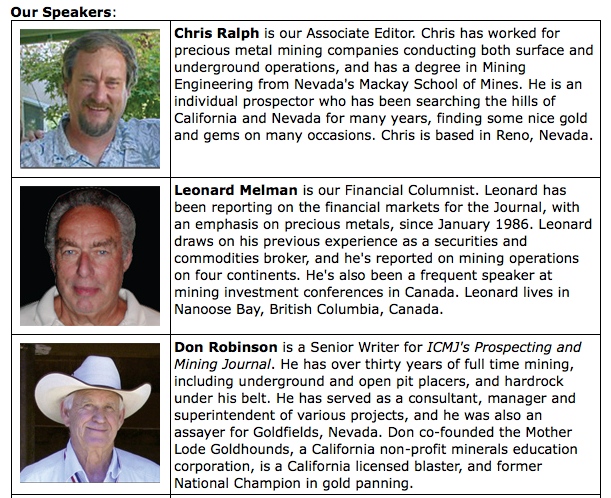
Get all the details of ICMJ's 2016 Mining Summit here. While in Placerville, you might also want to check out these other nearby activities:
Monday, February 01 2016
A drywasher is a machine that uses air, vibration, and static electricity to effectively separate gold from waste Drywashers are operated by shoveling gold-bearing gravels into an upper box which is covered with a screen. The larger rocks that are too big to pass through the screen slide off. Gravel small enough to go through is fed down into the lower gold recovery box, which is an inclined trough with cross riffles much like a sluice. The bottom of the recovery box consists of a thin, light-weight porous cloth. Beneath the riffle box is a blower that pulses air up through the cloth. The vibrations and air flow, combined with the shaking and classifying action of the dry washer allows the gold to settle to the bottom where it is captured in the riffles. With weather experts forecasting the strongest El Nino in half a century, dry washing should be very lucrative this winter. After being dry for so long, the predicted flash floods and high water events will replenish previously "worked out" areas. After all, nothing moves gold like water! Heavy rains and strong winds will cause erosion and mudslides that in turn move sands, gravel, rocks and even large boulders. The greater the volume and velocity of the water, the larger the gold and the further distance it will be moved until the water slows and the gold settles. As the fast-moving water eventually slows, "new" gold that has been unearthed will drop out of suspension and settle where it may, creating a layer of flood gold on or close to the surface. If El Nino is as strong as predicted, you'll find gold on the surface and maybe only 8 or 10 inches down, which means a lot less digging. Following a flash flood, you’ll often see black sand on the surface because it didn’t have enough time to work its way down. This clue tells you to do a test pan. You can dry pan or carry a little water. Test panning is a good idea even if the ground itself is too wet to drywash just yet. It’s never too wet to classify and prep the material to dry out in the sun! Once the floods are over and the dirt dries out, take advantage of the conditions and get out there with a drywasher. And when you do, keep these tips in mind:
NOTE TO CALIFORNIA PROSPECTORS: At a time when California legislators have refused to issue suction dredge permits to miners, dry washing may soon be the only unregulated activity left in the Golden State! With the new state-wide restrictions under Senate Bill 637 on the use of high bankers and suction dredges, some prospectors are starting to find a lot of gold deposits using dry washers in the California Mother Lode country. Good luck! Shop for a drywasher here and enjoy FREE SHIPPING in the Lower 48 on $350 purchases! Nugget of News Blog Monday, January 04 2016
Whether young, old, or somewhere in the middle, the shows offer something for everyone and provide the best opportunities to learnnew skills, see product demos, and rub elbows with some of the most respected miners and metal detectorists in the business! Mark your calendars and we'll see you there! Tuesday, December 01 2015
With the weather turning colder, you might think you're done prospecting 'til next summer, but you don't have to be! Even if you're not a regular snowbird heading to a warmer climate for the next few months, Gold mining in the desert is especially enjoyable if you're not into crowds— the desert can be delightfully smog free and people free in the winter. Experts say there is just as much gold waiting to be taken out of the desert as there is commonly found in streams and rivers. Why? Well, throughout history the desert mines just never got the publicity that wet places like California's Mother Lode did, so fewer prospectors went there. Plus, back in the day, mining used to be harder in dry conditions. Luckily that's no longer true if you have the right equipment.
• Metal detecting is another great way to hunt for gold in the desert. Gold detectors are not necessarily higher in cost, but they are built with a higher sensitivity to detecting gold nuggets, and have better ground balancing and • A bonus of prospecting in the desert is the abundance of interesting rocks. You can find many unusual rocks and semi-precious gems such as tourmaline, turquoise, agate, jasper, and more. Lapidary shops can cut and polish the rocks for you, or buy your own rock tumbler and lapidary tools and learn a new hobby. This winter, consider extending your gold-getting season with a prospecting trip to a sunnier, warmer state. Good luck and have fun! |
|
Nugget of News Blog |






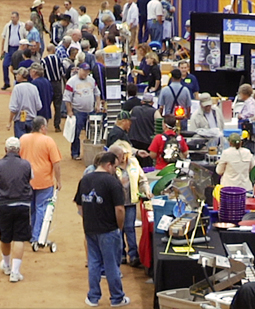 and metal detecting for years, these three shows offer a fun opportunity to rub elbows with some of the best in the business. In addition to browsing the show floor to find the latest and greatest equipment and supplies, meet Kevin Hoagland, host of Gold Trails.
and metal detecting for years, these three shows offer a fun opportunity to rub elbows with some of the best in the business. In addition to browsing the show floor to find the latest and greatest equipment and supplies, meet Kevin Hoagland, host of Gold Trails. 
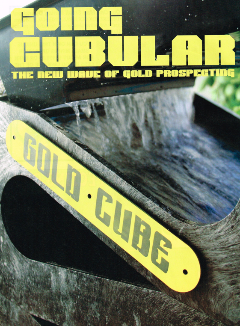
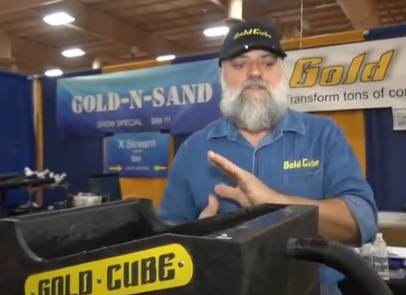 sands. The real reason the Gold Cube was invented was their nemesis— fine
sands. The real reason the Gold Cube was invented was their nemesis— fine 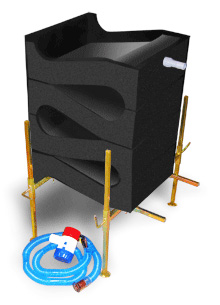 Deciding whether to go with a three-stack or four-stack depends on the type of gold itself. The flatter something is, the more it acts like a kite. Kiting is when the gold is so flat that it catches water, flips, and then sails over the waves. The flatter the gold, the more you'll require a
Deciding whether to go with a three-stack or four-stack depends on the type of gold itself. The flatter something is, the more it acts like a kite. Kiting is when the gold is so flat that it catches water, flips, and then sails over the waves. The flatter the gold, the more you'll require a 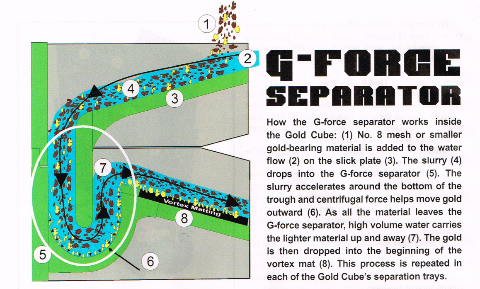 The fine gold becomes heavier and is moved to the outside edge because of centrifugal force. The gold drops to the bottom and starts scooting up that wall. And, as it leaves the G-force separator, it hits a lip just before it gets to the vortex mat. That edge is the only eddy in the entire system— a low-pressure zone necessary to pull the gold in front of the mat. With a sluicebox, you try hard to get the gold underwater, but with a Gold Cube, the gold doesn't have a choice; it goes under water, under that gate and the low pressure eddy exiting the G-force separator sucks the gold right up in front of the mat. The gold has nowhere to go except into the matting.
The fine gold becomes heavier and is moved to the outside edge because of centrifugal force. The gold drops to the bottom and starts scooting up that wall. And, as it leaves the G-force separator, it hits a lip just before it gets to the vortex mat. That edge is the only eddy in the entire system— a low-pressure zone necessary to pull the gold in front of the mat. With a sluicebox, you try hard to get the gold underwater, but with a Gold Cube, the gold doesn't have a choice; it goes under water, under that gate and the low pressure eddy exiting the G-force separator sucks the gold right up in front of the mat. The gold has nowhere to go except into the matting.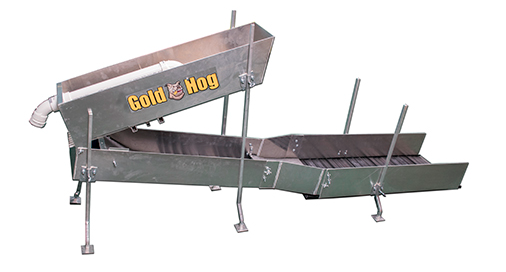
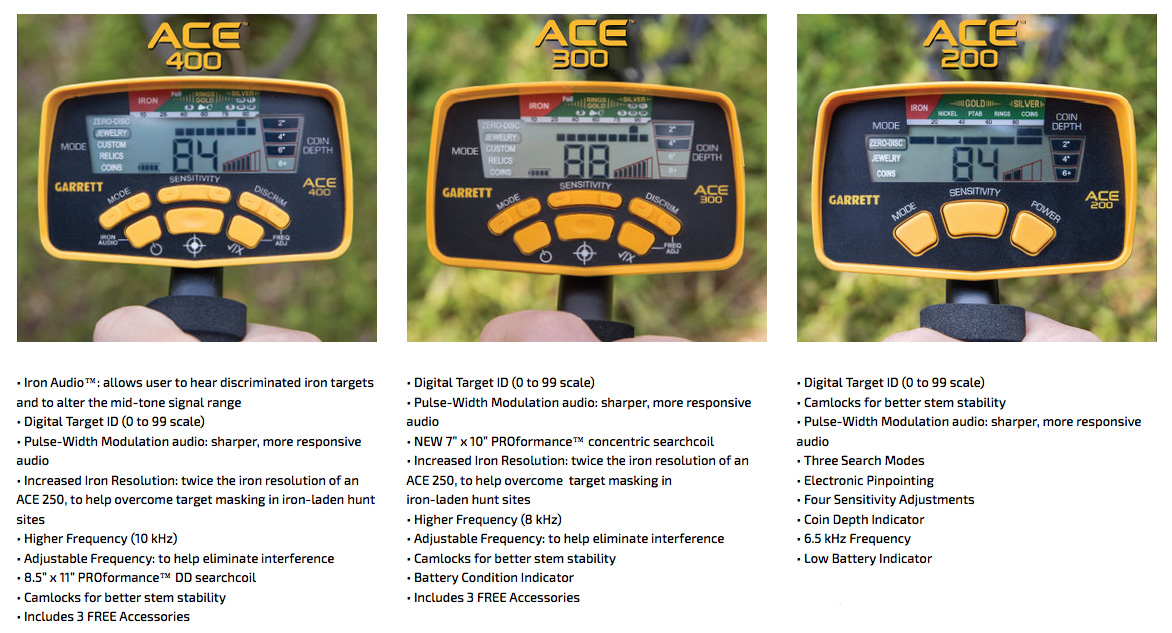

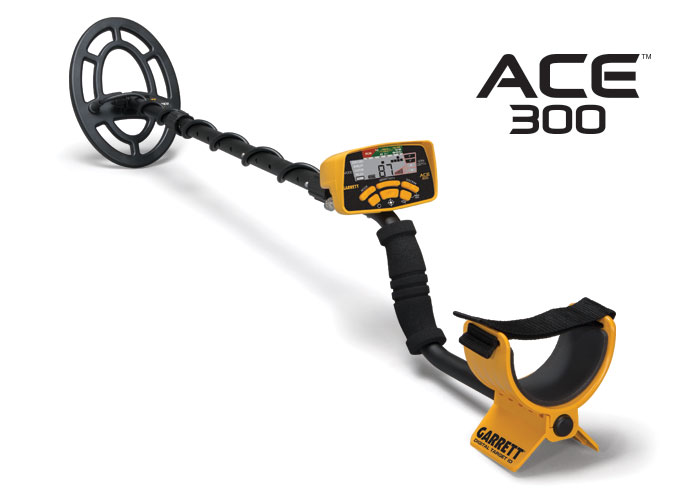
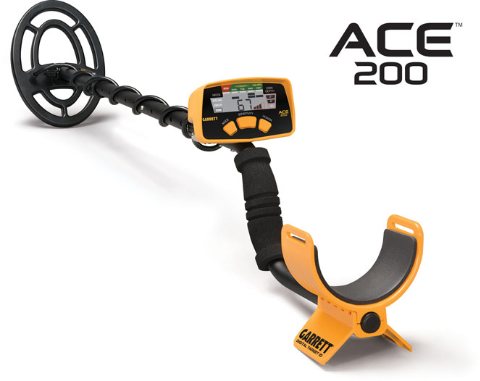
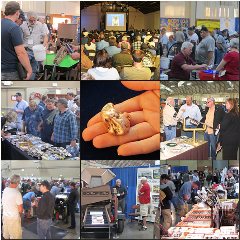
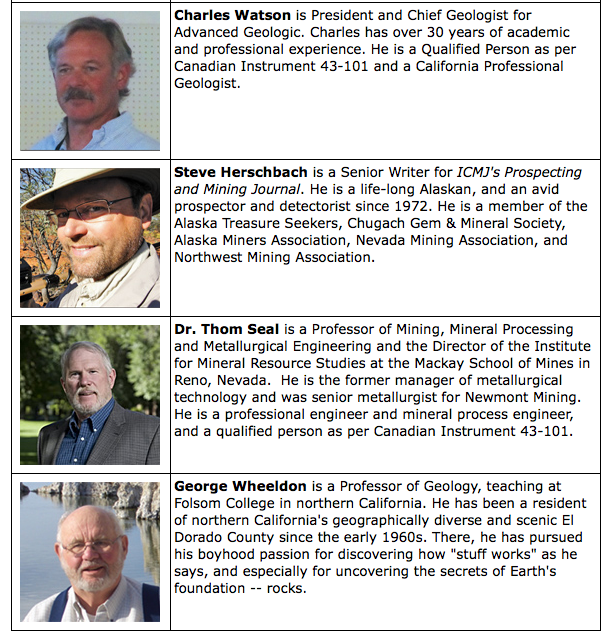
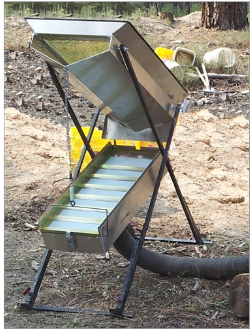
 If you’ve been thinking that mining for gold, metal detecting, or rockhounding seem like exciting hobbies you and your family would like to start, or if you've been doing it for years and just want to find out what's new in the industry, then make plans this spring to attend a Gold Prospectors Association of America (GPAA) Gold & Treasure Show and/or the 2-day ICMJ Prospecting & Mining Summit.
If you’ve been thinking that mining for gold, metal detecting, or rockhounding seem like exciting hobbies you and your family would like to start, or if you've been doing it for years and just want to find out what's new in the industry, then make plans this spring to attend a Gold Prospectors Association of America (GPAA) Gold & Treasure Show and/or the 2-day ICMJ Prospecting & Mining Summit.